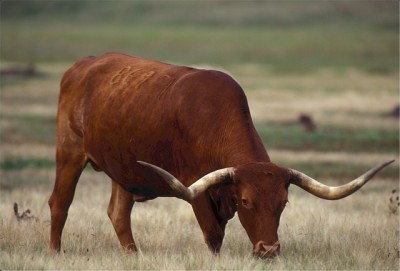I loved those old Robert Mitchum “beef, it’s what’s for dinner” commercials, and I like the new beef commercials with Sam Elliot, too.
What could be better than the life these commercials portray? Families around the nation sitting down and enjoying a meal, like things used to be. And at the center of every table: beef. Americans eat more beef than any other nation on this planet.
Having cattle on your farm can be a huge benefit – and it doesn’t stop with the beef. One cow produces, on average, 12 tons of nitrogen-rich manure a year, perfect for fertilizing your fields and gardens. Manure is the best fertilizer for your crops and also can be sold. People will pay for organic manure.
For the small farm and homestead, there are several breeds I really like. Each of them has different strengths.
I have built my list favoring a few breeds that have a good market in the US, since one goal with any beef cattle breed is meat production.
1. Texas Longhorn. This is, by far, my favorite breed to raise. Why? Because I can leave them on pasture for weeks at a time without checking them, and they will be just fine. Not that I leave them alone for weeks at a time, but I could. The Longhorn comes from a very ancient breed of cattle. They are very hardy, and can get by just fine without you. They don’t need help birthing their young, which is a huge plus to small farmers. Their meat is extremely lean and considered a delicacy by many. Longhorns are often used to breed with other cattle, and people will pay for your bull to breed their cattle; bull semen from Longhorns has a strong market in North America.
Everything You Need To Know To Keep A Cow Healthy, Happy, And Productive…
Longhorns are not picky eaters. They will eat grass, shrubs, hay, corn — just about anything organic. They are very docile, and good around families. Just watch those horns, as they can unintentionally gauge you.
2. Angus. Angus cattle are one of the most popular breeds of cattle in the US. They are excellent meat producers and can easily give you 50 percent of their weight in meat alone. Angus are fairly hardy for cattle, and can be left alone for some time. Where I live in the southeastern USA, well over half of all cattle farmers have Angus. The numbers go up the further west you go, and in Montana and Wyoming Angus seemingly outnumber people! Free-ranging the cattle is very common, perhaps using supplemental hay and corn.
The one disadvantage with Angus is, like many other breeds, they can have a hard time calving. It is not uncommon for farmers to have to assist. If you can’t bring yourself to do this, stick with a hardier breed or avoid cattle.
3. Highland Cattle. There is not that large of a market for Highland cattle as there once was. But it still exists. The meat is very tender and rich. You haven’t lived until you’ve had a Highland porterhouse steak. The breed is very hearty, like the Longhorn, and well-adapted for colder clients and higher elevations. Not the best breed for Georgia and Florida. The thick fur coat will keep these critters cold in well under freezing conditions.
Highland cattle are great grazers and do very well free-ranging. They have a high butter fat content in their milk, and can be used as the family dairy cow as well as a meat-provider.
4. Hereford. Another good meat producer. Hereford cattle are common in the US and Canada as a beef cattle breed. Like the Angus, you will have to keep a close eye on the cows during calving season, and some assistance to the new mothers may be needed. They are very similar in temperament to Angus, but require a little more oversight. Like Angus, they will fetch decent prices at the market for live cattle.
What types of beef cattle would you add to this list? Share your advice in the section below:
 Off The Grid News Better Ideas For Off The Grid Living
Off The Grid News Better Ideas For Off The Grid Living







